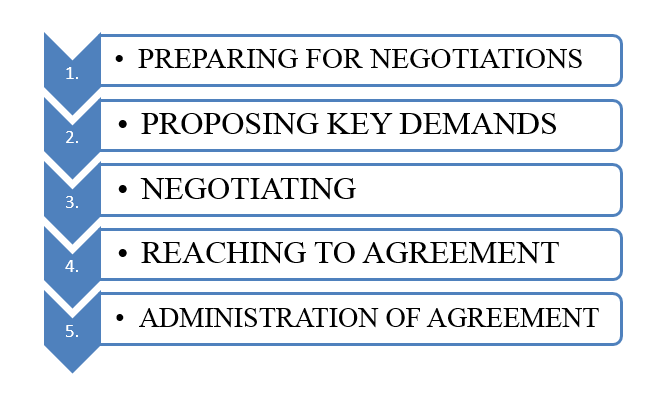INTRODUCTION
Every company consists of employees and employers. They are a group of people with their own opinions. In other words, the thoughts of people do not match. It differs from person to person. Hence, different ideas lead to disputes. Therefore, organizational conflicts and disputes are inevitable.
There is a need for discussion and negotiation to settle the dispute between employees and employers. Then, the two parties can conclude. This process is collective bargaining, where both parties agree on the decision. In simple words, collective bargaining is negotiations about working conditions.
Sidney and Beatrice Webb first used the term collective bargaining in the early twentieth century. According to them, this concept was the allied equivalent of individual negotiation. The main objective of collective bargaining was to gain economic advantage.
PROCESS OF COLLECTIVE BARGAINING
The collective bargaining process mainly consists of three stages. They are:
1) The identification stage
In the first stage, i.e., the identification stage, both parties identify the problems. They discuss various factors. Such as:
- Which issues are urgent?
- Which trouble can hold for some time?
- Selection of representatives
- Size of representatives
- Negotiation period
- Agreement duration
2) The negotiation stage
A chief negotiator from the management side is present for this stage. The chief negotiator presides the process while negotiating for the agreement. Also, he or she presents the problems and its scopes. Then, the chief negotiator invites views from both parties. The employer and the employees put their opinions forward. The chief negotiator then analyzes the arguments and counter-arguments. Lastly, she or he gives a solution suitable for both parties.
3) The stage of contract administration
The last stage of collective bargaining is the stage of contract administration. This stage decides whether collective bargaining is a success or not. The solution from the chief negotiator is made into a contract. Both parties should carefully read the agreement. They should understand all the terms and conditions. Also, both parties should explain the agreement to all the workers. Moreover, the collective bargaining will be effective if they build support for the productive administration of the contract.
Breaking the process in a simpler form we get:

TYPES OF COLLECTIVE BARGAINING
- Distributive bargaining
Distributive bargaining is a type of negotiation where one party benefits at the other party’s expense. In other words, it is redistribution of income. The deal takes place in the form of financial benefits, bonuses, pay raises, and so on. In simple words, this type of collective bargaining refers to the transfer of money.
- Integrative bargaining
Integrative bargaining is a type of collective bargaining where both parties aim to benefit. In other words, it is a type of ‘win-win’ negotiation. Both sides put their demands and conditions on the table. Both parties consider each other’s opinions, threats, concerns, and needs. Then, they conclude that benefits both employees and employers.
- Productivity bargaining
Productivity bargaining is another type of collective bargaining. Here, both parties’ concern is to boost the productivity of the organization. There are several ways to do it. Some are:
- Higher salaries
- Target-oriented bonuses
- Innovative ways
- New ways of organizing the workforce
- Taking risks
- Saying yes to changes
- Composite bargaining
Composite bargaining is not much related to money. It is a type of collective bargaining that focuses more on employee welfare and job security. It is a negotiation for favorable working conditions, suitable policies, fair recruitment, and disciplinary processes. The main objective of composite bargaining is to develop a relationship among the employees and the employers. This negotiation addresses the problems of both parties and provides solutions. Hence, it ensures long-term bonding.
- Concessionary bargaining
Sometimes, employees provide previous benefits to the employer. For instance, employees can agree to lower salaries in return for job security. This type of collective bargaining is concessionary bargaining. During an economic recession, employees can feel job security is more important. So they give back the benefits to the employers. This way, both parties benefit. It strengthens the business as well as ensures the survival of the employees.
ADVANTAGES OF COLLECTIVE BARGAINING
- Provides louder voice to employees
In most of the organizations, there is no union of employees. So, the employees are individuals. Due to this, they feel difficulty in negotiating. Most of them face ‘take it or leave it’ situation. Collective bargaining lets employees form into a larger group. It makes their voice bigger. Thus, workers can support each other and have mutually beneficial outcomes.
- Improvement in quality of life
Collective bargaining addresses the problems of both parties. It provides solutions to the employees and the employers. This way, employees can enjoy their rights. Also, employers can strengthen their business. Hence, it results in an improved quality of life for both parties.
- Develops relationship between both parties
Collective bargaining improves the relationships in three groups. They are:
- Among the employees
- Among the employers
- Between the employees and the employers
During collective bargaining, employees come together as a group. They share their opinions and discuss their problems. This makes them come closer. The same thing happens to employers as well. Moreover, after the negotiation, both parties agree to a particular decision. Their interests are respected. So there is a ‘win-win’ situation. Hence, the relationship between the parties also develops.
DISADVANTAGES OF COLLECTIVE BARGAINING
- Collective bargaining can be time-consuming
Collective bargaining includes all the members of an organization. Then each member tells about their issues. The process to analyze the problem, negotiate about it, come to a solution, and make both parties agree on it can be lengthy. So, collective bargaining consumes a lot of time.
- Reduces productivity
During collective bargaining, most of the employees do not work. All of them are busy in negotiation. So, the employees take leave. Similarly, employers become busy. So, there is no one to manage the organization. It decreases the productivity of an organization.
- Does not guarantee profit for both parties
Sometimes, one party can be in loss during collective bargaining. It also changes the workplace environment.







